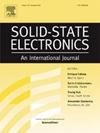LM和UMM结构GaAs三结太阳电池在1mev中子辐照下的辐射效应比较
IF 1.4
4区 物理与天体物理
Q3 ENGINEERING, ELECTRICAL & ELECTRONIC
引用次数: 0
摘要
研究了晶格匹配(LM)和直立变质(UMM)砷化镓三结太阳能电池在 1 MeV 中子辐照下的输出性能。结果表明,随着中子辐照通量的增加,太阳能电池的电气性能(包括开路电压、短路电流、最大输出功率和填充因子)严重下降。同时,随着中子辐照通量的增加,太阳能电池的串联电阻和并联电阻分别增大和减小。当辐照通量达到 6 × 1012 n/cm2 时,LM 和 UMM GaAs 电池的最大输出功率衰减基本相同,分别为初始值的 72.9% 和 72.3%。通过比较综合电流密度,可以发现 LM 电池中的限流子单元始终是 GaAs 中间单元,而在 UMM 电池中,经过高通量中子辐照后,限流单元从 GaInP 顶部子单元变为 GaInAs 中间子单元。本文章由计算机程序翻译,如有差异,请以英文原文为准。
Comparison of radiation effects of LM and UMM structure GaAs triple-junction solar cells under 1 MeV neutron irradiation
The output performances of lattice-matched (LM) and upright metamorphic (UMM) GaAs triple-junction solar cells under 1 MeV neutron irradiation were studied. The results show that the electrical performance, including open-circuit voltage, short-circuit current, maximum output power and fill factor of the solar cells were degraded seriously with the increase of neutron irradiation fluence. Meanwhile, the series resistance and the shunt resistance of solar cells are increased and decreased, respectively, when the neutron irradiation fluence increased. The degradation of maximum output power in LM and UMM GaAs cells is about the same level of 72.9 % and 72.3 % of its initial values, respectively, when the irradiation fluence is reached 6 × 1012 n/cm2. By comparing the integrated current densities, it was found out that the current-limiting subcell in LM cells s always GaAs middle cell, and in the UMM cell, the current limiting unit is changed from GaInP top subcell to GaInAs middle subcell after high fluence neutron irradiation.
求助全文
通过发布文献求助,成功后即可免费获取论文全文。
去求助
来源期刊

Solid-state Electronics
物理-工程:电子与电气
CiteScore
3.00
自引率
5.90%
发文量
212
审稿时长
3 months
期刊介绍:
It is the aim of this journal to bring together in one publication outstanding papers reporting new and original work in the following areas: (1) applications of solid-state physics and technology to electronics and optoelectronics, including theory and device design; (2) optical, electrical, morphological characterization techniques and parameter extraction of devices; (3) fabrication of semiconductor devices, and also device-related materials growth, measurement and evaluation; (4) the physics and modeling of submicron and nanoscale microelectronic and optoelectronic devices, including processing, measurement, and performance evaluation; (5) applications of numerical methods to the modeling and simulation of solid-state devices and processes; and (6) nanoscale electronic and optoelectronic devices, photovoltaics, sensors, and MEMS based on semiconductor and alternative electronic materials; (7) synthesis and electrooptical properties of materials for novel devices.
 求助内容:
求助内容: 应助结果提醒方式:
应助结果提醒方式:


